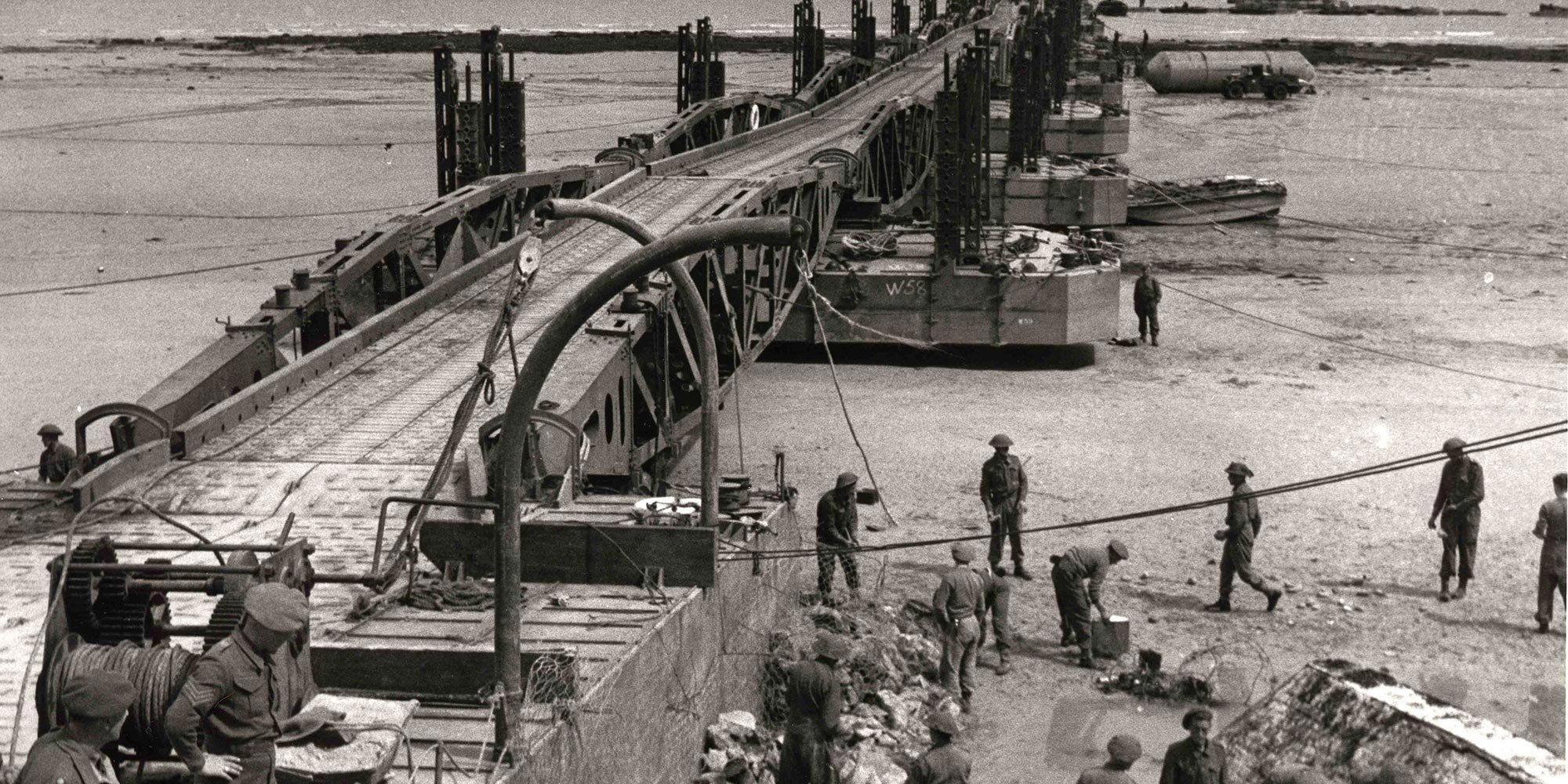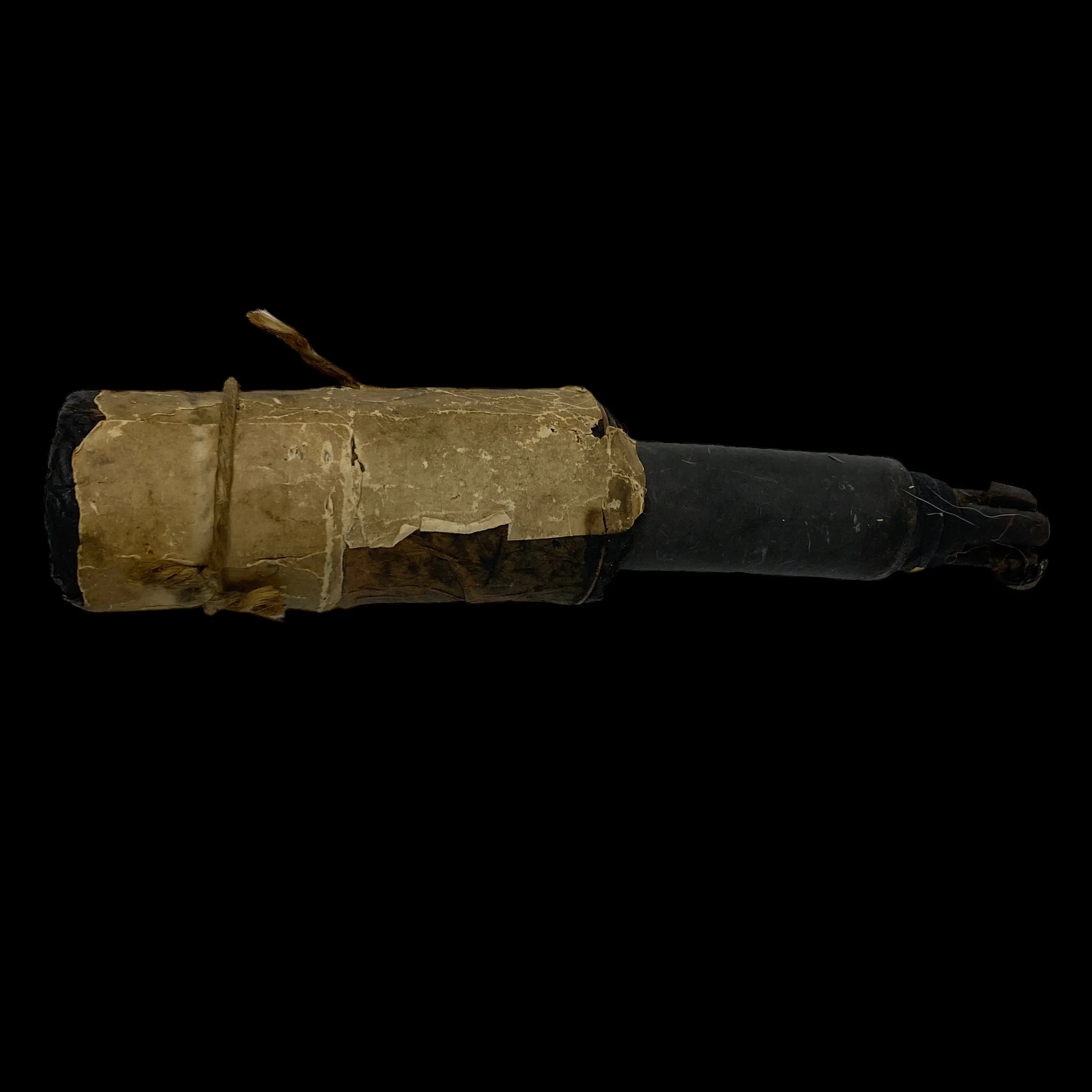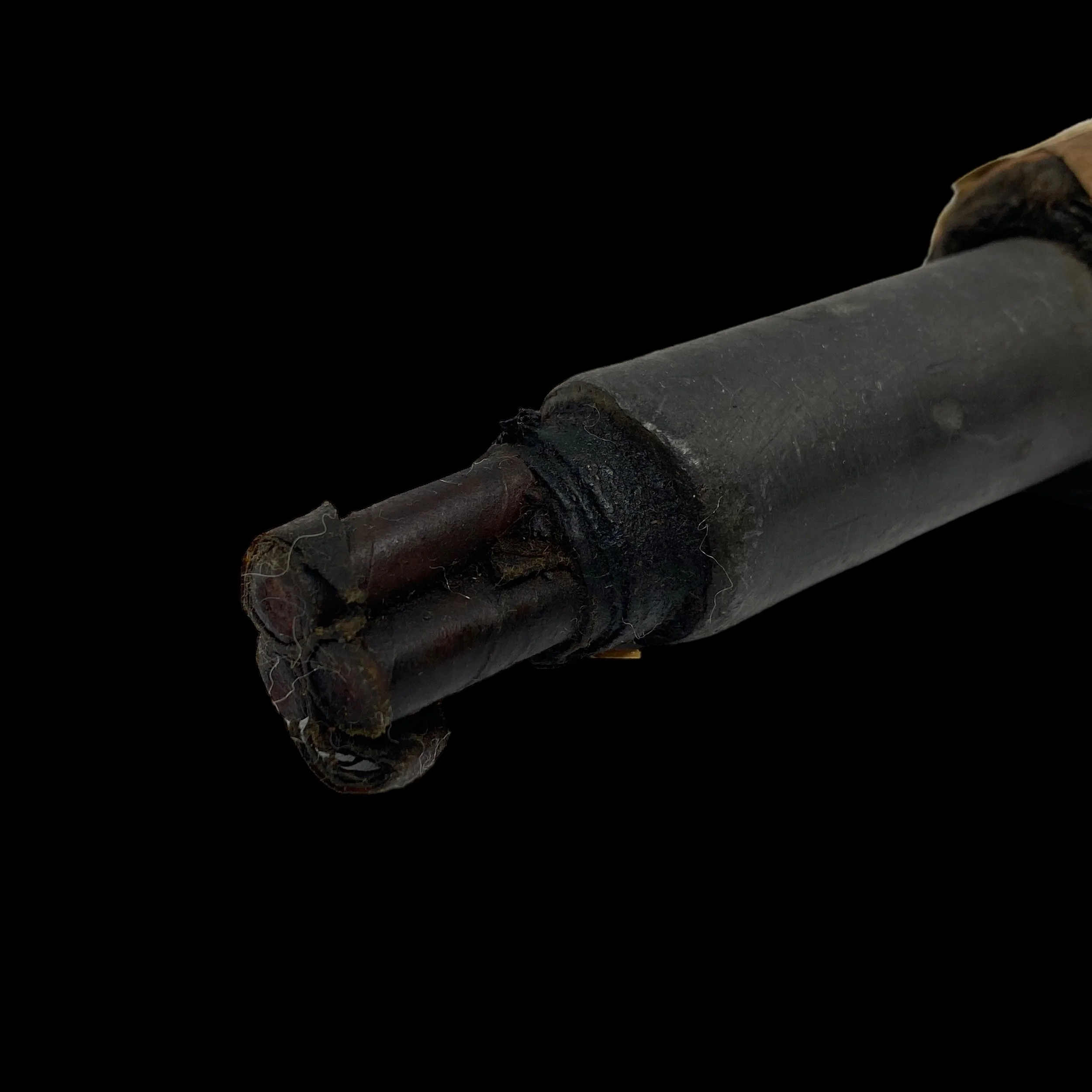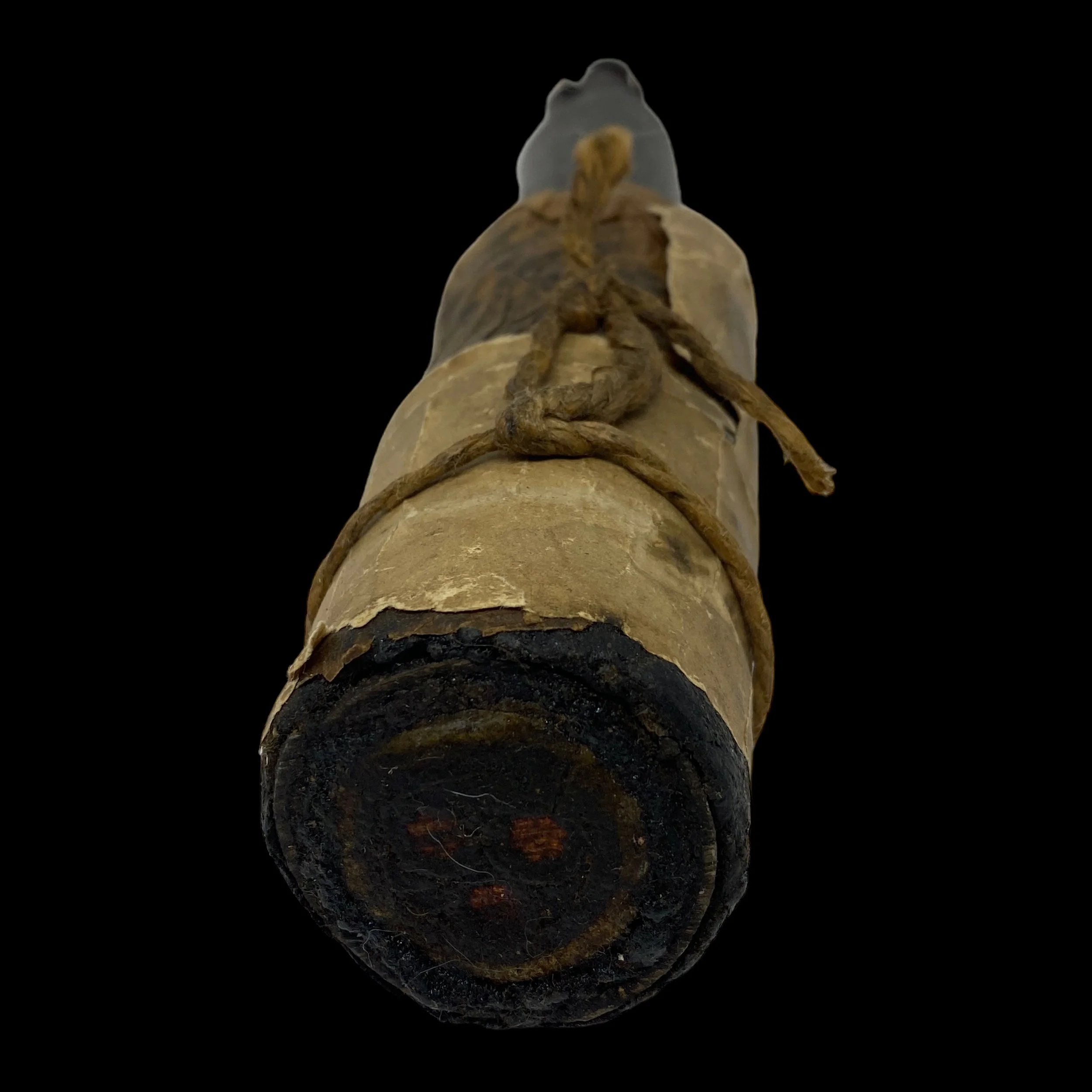EXTREMELY RARE! WWII D-Day Operation Overlord Omaha Beach “Mulberry Harbor A” Tension Cable
























EXTREMELY RARE! WWII D-Day Operation Overlord Omaha Beach “Mulberry Harbor A” Tension Cable
Comes with hand-signed C.O.A. and a full historical write-up
This is a once-in-a-lifetime chance to own this piece of history. This is the only Mulberry harbor cable currently for sale in the public sector making this an EXTREMELY RARE artifact from the D-Day landings and Operation Overlord. The name of the soldier (most likely apart of the “Mulberry A” engineers) that saved this section of cable is lost as the name does not appear on the makeshift paper wrap. In our years of experience, this is the second Mulberry artifact we have ever had the chance to work with.
This extremely rare and museum-grade WWII D-Day Operation Overlord artifact is a large tension cable from the infamous Omaha Beach “Mulberry Harbor A” that was constructed off Saint-Laurent at Omaha Beach in the American sector. The various parts of the Mulberries were fabricated in TOP SECRECY in Britain and floated into position immediately after D-Day. Within 12 days of the landing (D-Day +12), both harbours were operational. At Omaha and Utah, 6,614 tons of cargo was discharged in the first 3 days. A month after D-Day, Omaha and Utah were handling 9,200 tons, and after a further month, they were landing 16,000 tons per day. This increased until 56,200 tons of supplies, 20,000 vehicles, and 180,000 troops were discharged each day at those beaches.
The Mullbery Harbors were intended to provide the primary means for the movement of goods from ship to shore until the port at Cherbourg was captured and opened. However, on June 19 a violent storm began, and by June 22 the American harbour was destroyed. (Parts of the wreckage were used to repair the British harbour.) The Americans had to return to the old way of doing things: bringing landing ships in to shore, grounding them, off-loading the ships, and then refloating them on the next high tide. The British Mulberry supported the Allied armies for 10 months. Two and a half million men, a half million vehicles, and four million tons of supplies landed in Europe through the artificial harbour at Arromanches. Remains of the structure can be seen to this day near the Musée du Débarquement.
Omaha Beach “Mulberry Harbor A” History:
On the afternoon of 6 June 1944 (D-Day) over 400 towed component parts (weighing approximately 1.5 million tons) set sail to create the two Mulberry harbours. It included all the blockships (codenamed Corncobs) to create the outer breakwater (Gooseberries) and 146 concrete caissons (Phoenixes).
Arriving first on D-Day itself were the Bombardons followed a day later by the first blockship. The first Phoenix was sunk on 9 June and the Gooseberry was finished by 11 June. By 18 June two piers and four pier heads were working. Though this harbour was abandoned in late June (see below), the beach continued to be used for landing vehicles and stores using Landing Ship Tanks (LSTs). Using this method, the Americans were able to unload a higher tonnage of supplies than at Arromanches. Salvageable parts of the artificial port were sent to Arromanches to repair the Mulberry there.
Some troops from the American Ghost Army went to Normandy two weeks after D-Day to simulate a Mulberry harbour. The deception was created in such a way that at night its lights drew German gunfire away from the real Mulberries.
Mulberry harbours were two temporary portable harbours developed by the British Admiralty and War Office during the Second World War to facilitate the rapid offloading of cargo onto beaches during the Allied invasion of Normandy in June 1944. After the Allies successfully held beachheads following D-Day, two prefabricated harbours were taken in sections across the English Channel from southern England with the invading armies and assembled off Omaha Beach (Mulberry "A") and Gold Beach (Mulberry "B"). The Mulberry harbours were to be used until major French ports could be captured and brought back into use after repair of the inevitable sabotage by German defenders. The Mulberry B harbour at Gold Beach was used for 10 months after D-Day, and over 2.5 million men, 500,000 vehicles, and 4 million tons of supplies were landed before it was fully decommissioned. The still only partially-completed Mulberry A harbour at Omaha Beach was damaged on 19 June by a violent storm that suddenly arrived from the north-east. After three days the storm finally abated and damage was found to be so severe that the harbour had to be abandoned.
Each Mulberry harbour consisted of roughly 6 miles (10 km) of flexible steel roadways (code-named Whales) that floated on steel or concrete pontoons (called Beetles). The roadways terminated at great pierheads, called Spuds, that were jacked up and down on legs which rested on the seafloor. These structures were to be sheltered from the sea by lines of massive sunken caissons (called Phoenixes), lines of scuttled ships (called Gooseberries), and a line of floating breakwaters (called Bombardons). It was estimated that construction of the caissons alone required 330,000 cubic yards (252,000 cubic metres) of concrete, 31,000 tons of steel, and 1.5 million yards (1.4 million metres) of steel shuttering.
Omaha Beach:
Omaha Beach, second beach from the west among the five landing areas of the Normandy Invasion of World War II. It was assaulted on June 6, 1944 (D-Day of the invasion), by units of the U.S. 29th and 1st infantry divisions, many of whose soldiers were drowned during the approach from ships offshore or were killed by defending fire from German troops placed on heights surrounding the beach.
Formally part of the Omaha invasion area was Pointe du Hoc, a promontory situated to the west of the landing beach. On D-Day it was the object of a daring seaborne assault by U.S. Army Rangers, who scaled its cliffs with the aim of silencing artillery pieces placed on its heights.
The largest of the D-Day assault areas, Omaha Beach stretched over 10 km (6 miles) between the fishing port of Port-en-Bessin on the east and the mouth of the Vire River on the west. The western third of the beach was backed by a seawall 3 metres (10 feet) high, and the whole beach was overlooked by cliffs 30 metres high. There were five exits from the sand and shingle beach; the best was a paved road in a ravine leading to the resort village of Vierville-sur-Mer, two were only dirt paths, and two were dirt roads leading to the villages of Colleville-sur-Mer and Saint-Laurent-sur-Mer.
The Germans under Field Marshal Erwin Rommel had built formidable defenses to protect this enclosed battlefield. The waters and beach were heavily mined, and there were 13 strongpoints called Widerstandsnester (“resistance nests”). Numerous other fighting positions dotted the area, supported by an extensive trench system. The defending forces consisted of three battalions of the veteran 352nd Infantry Division. Their weapons were fixed to cover the beach with grazing enfilade fire as well as plunging fire from the cliffs. Omaha was a killing zone.
Omaha Beach was part of the invasion area assigned to the U.S. First Army, under Lieutenant General Omar Bradley. The assault sectors at Omaha were code-named (from west to east) Charlie, Dog (consisting of Green, White, and Red sections), Easy (Green and Red sections), and Fox (Green and Red sections). The beach was to be assaulted at 0630 hours by the U.S. 1st Infantry Division, with the 116th Regiment of the 29th Division attached for D-Day only. Omaha was wide enough to land two regiments side by side with armour in front, and so the 116th Regiment was to land at Dog (Green, White, and Red) and Easy Green, while the 16th Regiment, 1st Division, was to land at Easy Red and Fox Green.
The objectives of the 1st Division were ambitious. First it was to capture the villages of Vierville, Saint-Laurent, and Colleville; then it was to push through and cut the Bayeux-Isigny road; and then it was to attack south toward Trévières and west toward the Pointe du Hoc. Elements of the 16th Regiment were to link up at Port-en-Bessin with British units from Gold Beach to the east.
From the beginning everything went wrong at Omaha. Special “DD” tanks (amphibious Sherman tanks fitted with flotation screens) that were supposed to support the 116th Regiment sank in the choppy waters of the Channel. Only 2 of the 29 launched made it to the beach. With the exception of Company A, no unit of the 116th landed where it was planned. Strong winds and tidal currents carried the landing craft from right to left. The 16th Regiment on the east half of the beach did not fare much better, landing in a state of confusion with units badly intermingled.
Throughout the landing, German gunners poured deadly fire into the ranks of the invading Americans. Bodies lay on the beach or floated in the water. Men sought refuge behind beach obstacles, pondering the deadly sprint across the beach to the seawall, which offered some safety at the base of the cliff. Destroyed craft and vehicles littered the water’s edge and beach, and at 0830 hours all landing ceased at Omaha. The troops on the beach were left on their own and realized that the exits were not the way off. Slowly, and in small groups, they scaled the cliffs. Meanwhile, navy destroyers steamed in and, scraping their bottoms in the shallow water, blasted the German fortifications at point-blank range. By 1200 hours German fire had noticeably decreased as the defensive positions were taken from the rear. Then one by one the exits were opened.
By nightfall the 1st and 29th divisions held positions around Vierville, Saint-Laurent, and Colleville—nowhere near the planned objectives, but they had a toehold. The Americans suffered 2,400 casualties at Omaha on June 6, but by the end of the day they had landed 34,000 troops. The German 352nd Division lost 20 percent of its strength, with 1,200 casualties, but it had no reserves coming to continue the fight.